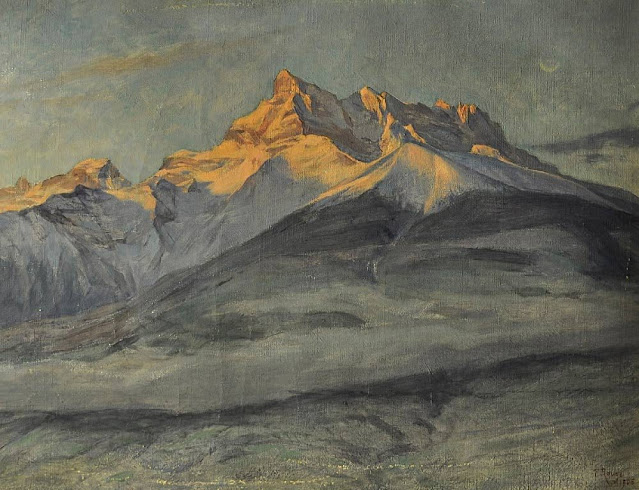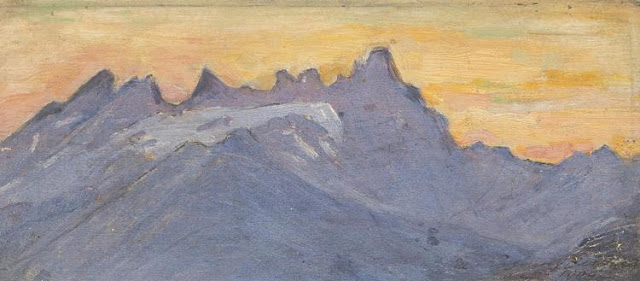Les Dents du Midi (3,114 m à 3,257 m)
Suisse
La peintre
Blanche Berthoud est une artiste peintre suisse de la région de Neufchâtel (Suisse) qui a été très active tout au long de la première moitié du XXe siècle. Elle fait partie de la Société romande des femmes peintres fondée par la peintre Jeanne Lombard (1865-1945) qui défend très farouchement les femmes peintres montagnardes, un monde souvent réservé aux hommes. Elle a réalisé plusieurs peintures et aquarelles du Breithorn, dont l'une a été acquise par le Musée d'Art et d'Histoire de Neufchâtel.
La montagne
Les Dents du Midi (3 114 m à 3 257 m -10 216 pi à
10 685 pi) sont un massif montagneux de 3 kilomètres de long situé dans
les Alpes du Chablais dans le canton du Valais en Suisse. Dominant au
sud la vallée d'Illiez et la vallée du Rhône, elles font face au lac de
Salanfe, retenue artificielle, et font partie de l'ensemble géologique
du massif du Giffre.
L'appellation « Dents du Midi » est récente.
Autrefois appelée "Dents Tsallen". ce n'est que vers la fin du 19e
siècle que l'appellation « Dents du Midi » a été officiellement a
utilisée. Chaque « dent » a eu plusieurs noms au fil des siècles, selon
son évolution géologique.
- La "Cime de l'Est" (3178 mètres) appelée
"Mont Novierre" avant le milieu du 17ème siècle, et "Mont Saint-Michel"
après des éboulements en 1635 et 1636 et enfin "Dent Noire" (jusqu'au
19ème siècle) .
- La "Dent Jaune" (3186 m) s'appelait la "Dent Rouge" jusqu'en 1879.
-
Le "Doigt de Champéry" (en 1882) puis le Doigt Salanfe (en 1886) se
transforme juste en "Les Doigts" (Doigts) (3205 m et 3210 m).
- La
"Haute Cime" (3257 m) eut aussi plusieurs noms : "Dent de l'Ouest"
(jusqu'en 1784) puis "Dent du Midi", "Dent de Tsallen" et "Dent de
Challent".
- Quant à l'Eperon (3114 m) (L'Eperon), on suppose qu'il y
avait deux sommets mais un éboulement au Moyen Age a considérablement
modifié sa crête.
- La Forteresse (3164 m) et la Cathédrale (3160 m) n'ont pas changé de nom.
L'évolution
de ce massif se poursuit de nos jours. Ainsi le matin du 30 octobre
2006, un volume de 1 million de m3 de roche se détachait du bord de la
Haute Cime et dévalait la pente jusqu'à environ 3000 m d'altitude.
L'événement n'a pas présenté de danger pour le village voisin de
Val-d'Illiez mais les routes et les sentiers ont été fermés pour des
raisons de sécurité. Selon le géologue cantonal, le glissement de
terrain a été causé par le dégel des roches, aidé par les étés chauds de
ces dernières années.
_________________________________________
2023 - Gravir les montagnes en peintureUn blog de Francis Rousseau
%20,%20oil%20on%20cardoarod,%20LEs%20dents%20du%20Midi,%201949.%20PC%20.png)
















